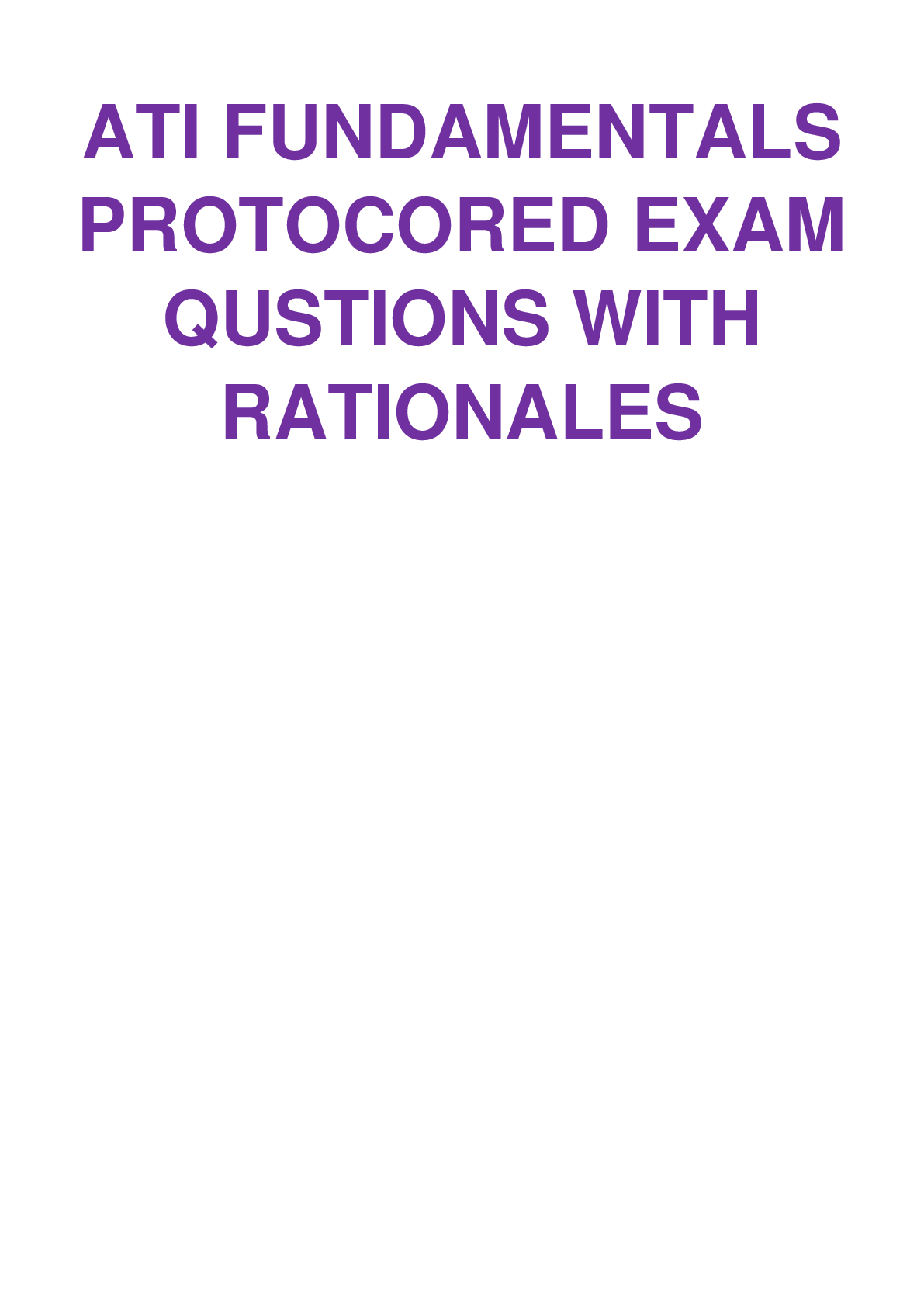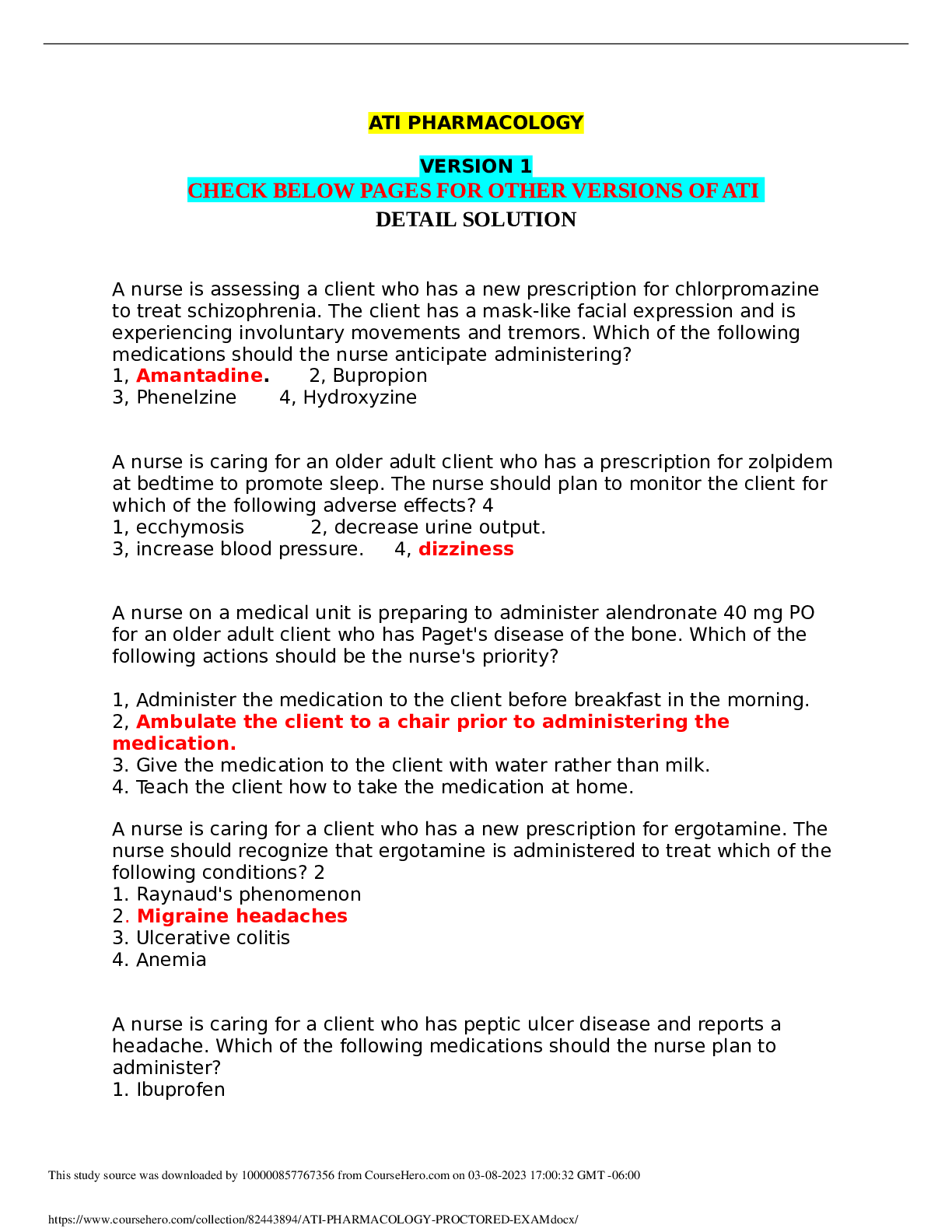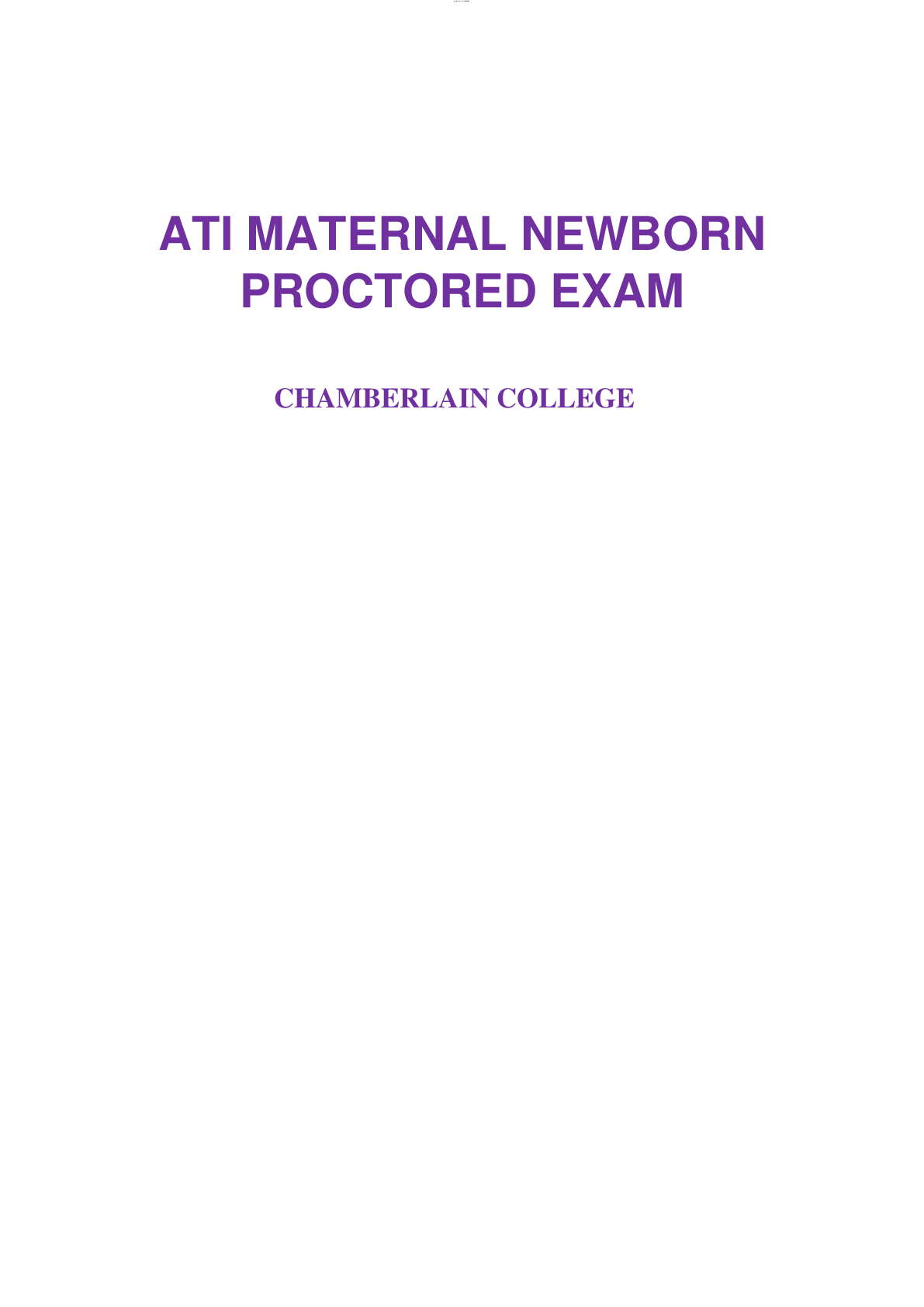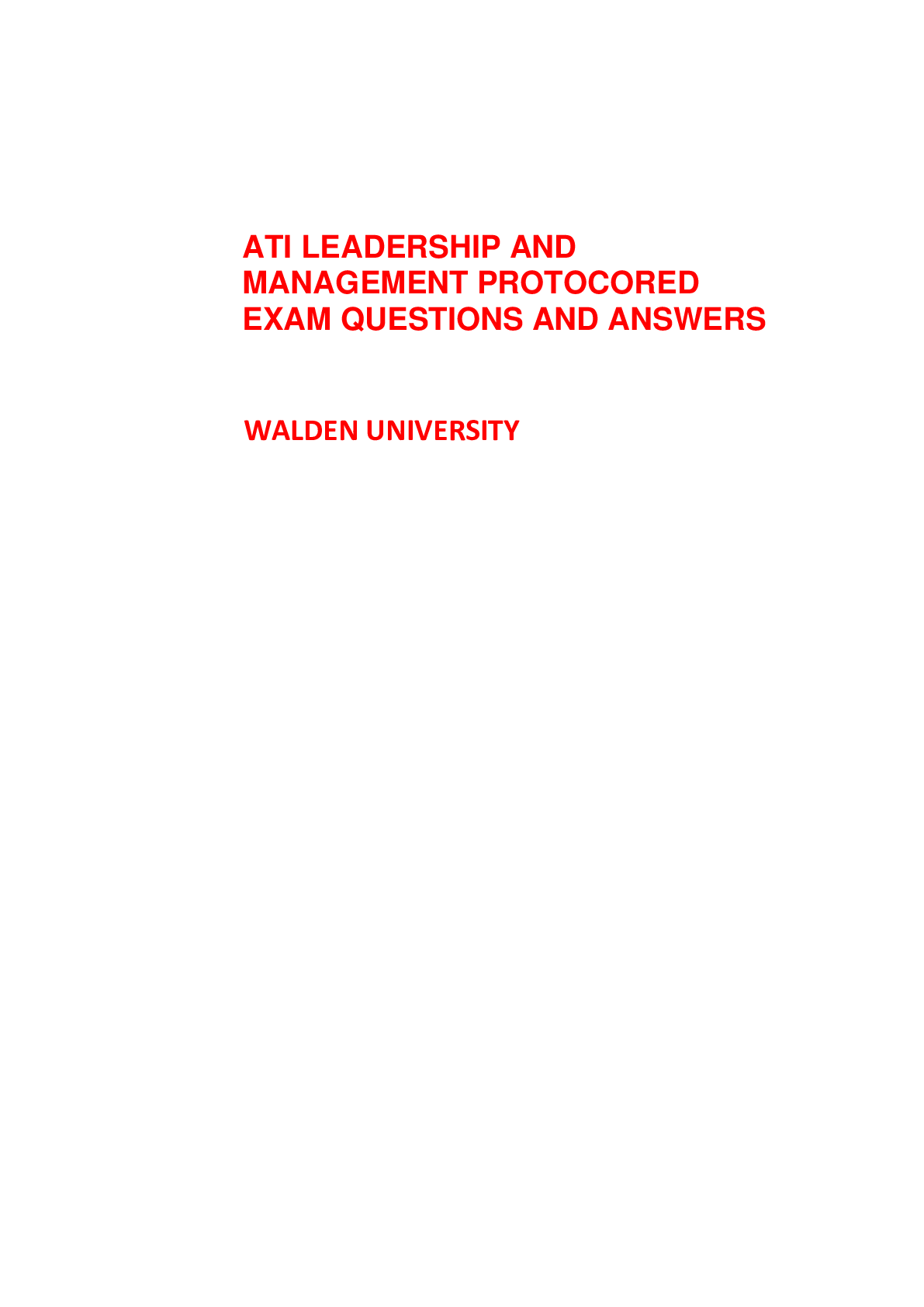ATI Nutrition Proctored Exam Questions and Answers (2021/2022) Rated A+
Document Content and Description Below
Foods high in potassium: Answer- apricots bananas potatoes tomatoes avocado fish spinach beans A nrse is reinforcing diet teaching to a patient who has type 2 DM. Which of the following ... should the nrse include in the teaching? Select all that apply. A. Carbs should comprise 55% of daily caloric intake B. Use hydrogenated oils for cooking C. Table sugar may be added to cereals D. Drink an alcoholic beverage w/meals E. Protein foods can be substituted for carb foods Answer- A, C, D Not B-hydrogenated oils contain trans fatty acids & cause hyperlipidemia Not E-carbs can be exchanged but not w/proteins A nrse is reviewing dietary guidelines to include in the plan of care for a patient who has type 2 DM. Which of the following guidelines should the nrse include? Select all that apply. A. Weight management B. Lipid profile C. Cultural needs D. Sleep patterns E. Personal preferences Answer- A, B, C, E To avoid hypoglycemia, the patient should consume alcohol... Answer- with a meal or immediately after a meal _______________can be included in a diabetic diet as long as adequate insulin or other agents are provided to cover the sugar intake. Answer- Sucrose (table sugar) The nrse should instruct the diabetic patient that their intake of carbohydrates should be ___to___% of total daily caloric intake. Answer- 45-60% The lacto-ovo vegetarian diet includes: Answer- dairy products and eggs A nrse is teaching a patient measures for healthy bones. Which of the following statements by the patient requires additional teaching? A. "I will eat foods high in calcium." B. "I will increase my fluid intake." C. "I should participate in weight bearing exercises." D. "I should get my vitamin D from the sunlight." Answer- B. increasing fluid does not promote healthy bones A nrse is conducting a nutritional class to a group of newly licensed nrses. Which of the following should be included in the teaching? A. Limit saturated fat to 10% of total caloric intake. B. Good bowel function requires 35 g/day of fiber for women. C. Limit cholesterol consumption to 400 mg/day D. Normal functioning cardiac systems depends on B-complex vitamins Answer- A A nrse is discussing essential nutrients for normal functioning of the nervous system. Which of the following should be included in the teaching? Select all that apply. A. Calcium B. Thiamin C. Vitamin B6 D. Sodium E. Phosphorus Answer- A, B, C, D A school nrse is teaching a group of students how to read food labels. Which of the following should be included in the teaching? Select all that apply. A. Total carbohydrates B. Total fat C. Calories D. Magnesium E. Dietary fiber Answer- A, B, C, E Normal functioning of the nervous system depends on adequate levels of the B-complex vitamins, especially: and also adequate levels of ____and _____for regulators of nerve responses. Answer- thiamin, niacin, vitamin B6 and B12 calcium and sodium normal BMI: Answer- 18.5-24.9 obesity BMI is classified as: Answer- BMI greater than or equal to 30 Basic food choices for kosher, orthodox Judaism diets: Answer- -meat -no mixing meat and diary (cheeseburger) -no pork or shellfish -fish must have scales & fins to be kosher A patient who follows seventh-day Adventist dietary laws will eat a strict: They also avoid: Answer- vegetarian diet, some are lacto-ovo, some are vegan. they avoid alcohol, coffee, tea and caffeinated beverages. A nrse is teaching a patient who has cancer about appropriate food choices. The nrse determines that the patient understands the information when she chooses which of the following snacks? Select all that apply. A. Peanut butter sandwich on whole wheat bread w/2% milk B. Popcorn w/soda C. Yogurt topped w/granola & a banana D. Meat lasagna w/buttered garlic bread E. Plain baked potato Answer- A, C, D Three complications of TPN: Answer- Diarrhea Polyuria Hypocalciumia What has more calcium yogurt or cheese? Answer- yogurt Niacin is found in sources such as: Answer- Beef liver nuts legumes whole-grain enriched breads and cereals Two medications may be added to PN solutions however administering any IV medication through a PN IV line or port is contraindicated. What are the two medications? Answer- Heparin and insulin Expected reference range for pre-albumin: Answer- 23-43 Which of the following food choices is appropriate for a pt. with GERD? Select all that apply. A. Baked salmon B. Skim milk C. Orange juice D. Decaffeinated tea E. Eggs and salsa Answer- A, B, D For which disease/condition would the nrse teach the patient about a gluten-free diet? A. A 54 year old man with pancreatitis. B. A 32 year old woman with celiac disease. C. A 22 year old man with diverticulitis. D. A 76 year old woman with breast cancer. Answer- B. Celiac disease is also known as gluten-sensitive enteropathy (GSE), celiac sprue, and gluten intolerance. It is chronic & hereditary and the patient should be instructed to avoid gluten. Foods/beverages that are gluten-free include: (select all that apply) A. Milk, cheese, dairy products B. Beer C. Fried Eggs D. Baked potatoes E. Fruits and vegetables F. Whole wheat bread Answer- A, C, D, E A patient who has celiac disease should increase intake of what? Answer- simple carbohydrates (fruits, veggies, milk, etc.) A nrse is providing instructions to a patient who has a new diagnosis of celiac disease. Which of the following food choices by the patient indicates a need for further teaching? A. Potatoes B. Graham crackers C. Wild rice D. Canned pears Answer- B. Graham crackers are made from wheat flour All others are gluten-free A patient with what disease will be instructed to avoid foods with seeds or husks (corn, popcorn, berries, tomatoes)? Answer- diverticular A nrse is providing instructions to a patient who reports constipation & has a prescription for a high-fiber, low-fat diet. Which of the following food choices by the patient indicates understanding of the teaching? A. Peanut butter B. Peeled apples C. Hardboiled egg D. Brown rice Answer- D A nrse is caring for a patient post appy. The nrse verifies the postop prescription, which reads "discontinue NPO status; advance diet as tolerated." Which of the following are appropriate for the nrse to offer the patient? Select all that apply. A. Applesauce B. Chicken broth C. Sherbet D. Wheat toast E. Cranberry juice Answer- B, E A patient postop will be on a clear liquid diet following surgery to transition as tolerated back to normal diet. Cranberry juice and chicken broth are clear liquid selections. A nrse is caring for a patient who is on a full liquid diet due to dysphagia. Which of the following nursing actions is the highest priority? A. Add thickener to liquids. B. Educate the patient about acceptable liquids. C. Perform a calorie count of consumed liquids. D. Offer high-protein liquid supplements. Answer- A this is highest priority to reduce the risk of aspiration A nrse is performing dietary needs assessments for a group of patients. A blenderized liquid diet is appropriate for which of the following patients? Select all that apply. A. A patient who has a wired jaw due to an MVA B. A patient who is 24 hr postop following temporomandibular joint repair C. A patient who has difficulty chewing due to a traumatic brain injury D. A patient who has hypercholesterolemia due to CAD E. A patient who is scheduled for a colonoscopy the next morning Answer- A, B, C A nrse is assessing a patient who is postop following a colon resection. Which of the following findings indicates that the patient is ready to transition from NPO to oral intake? A. Patient report of hunger B. Urinary output exceeding 30 mL/hr C. Decrease in incisional pain D. Passage of flatus Answer- D A nrse is assisting a patient who has a prescription for a mechanical soft diet w/food selections. Which of the following are appropriate selections by the patient? Select all that apply. A. Dried prunes B. Ground turkey C. Mashed carrots D. Fresh strawberries E. Cottage cheese Answer- B, C, E A nrse is teaching a patient who is undergoing cancer treatment about interventions to manage stomatitis. Which of the following statements by the patient indicates an understanding of the teaching? A. "I will try chewing larger pieces of food." B. "I will avoid toasting my bread." C. "I will consume more food in the morning." D. "I will add more citrus foods to my diet." Answer- B. Dry, coarse foods can increase the incidence/risk of stomatitis Which of the following food choices by a patient undergoing chemotherapy with presence of stomatitis indicates a need for further teaching? A. Small pieces of bananas B. Cut up fresh orange & pineapple slices C. Yogurt with granola D. Meat lasagna Answer- B A nrse is caring for a patient who has hypoglycemia. Which of the following is an appropriate action by the nrse? A. Offer crackers & cheese B. Encourage sucking on 8 hard candies C. Provide 8 oz of regular soda D. Give juice w/table sugar Answer- B Which of the following are appropriate dietary choices for a patient with cholecystitis? Select all that apply. A. Baked lightly-seasoned tilapia B. Buttered steamed broccoli C. Skim or 1% low fat milk D. Whole wheat toast E. Pasta with cream sauce and onions Answer- A, C Patients with gallstones, also known as cholecystitis, should avoid what in their diet? Answer- FAT A nrse is planning for an older adult patient who is receiving treatment for malnutrition. The patient is scheduled for discharge to his home where he lives alone. Which of the following actions are appropriate to include in the plan of care? (Select all that apply.) A. Consult social services to arrange home meal delivery B. Encourage the patient to purchase nonperishable boxed meals C. Advise the patient to purchase frozen fruits/veggies D. Recommend drinking a supplement between meals E. Educate the patient on how to read nutrition labels Answer- A, C, D, E Older adult patients will need more _____and vitamin ___to help maintain bone health. The may also be instructed to increase ____in their diet. Answer- calcium and vitamin D increase fiber Older adults have decreased absorption of what three nutrients? Answer- 1. Vitamin B12 2. Folic acid 3. Calcium The soft diet is also known as the bland, low fiber diet and contains foods such as: Answer- Whole foods that are low in fiber, lightly seasoned and easily digested. Is it safe to take antibiotics while breastfeeding? Answer- Yes, PO antibiotics are safe. Notify provider and finish entire course to reduce risk of reoccurence. There is a slight transfer between breast milk though. Food interactions with MAOIs include: Answer- tyramine-rich foods caffiene foods/beverages A nrse is providing follow-up dietary teaching for a patient who recently was prescribed phenelzine (Nardil). When reviewing the patient's dietary log, which of the following foods requires a need for further teaching? A. Cottage cheese B. Banana bread C. Apple pie D. Grilled steak Answer- B Intermittent tube feeding formula set rate: Answer- administered every 4-6 hr in equal portions of 200-300 mL over a 30-60 min time frame, usually by gravity drip Which type of tube feeding is often used in noncritical patients, home tube feedings, and patients in rehabilitation? Answer- intermittent tube feeding What should the head of the bed be elevated at for tube feedings and for how long? Answer- HOB at least 30 degrees and for during and after for 30-60 min to prevent aspiration risk How often should you obtain gastric residuals for a patient receiving tube feedings? Answer- every 4-6 hrs When beginning a new prescription for enteral nutrition by intermittent tube feeding how should you first initiate this feeding? Answer- Increase the formula over the first 4 to 6 feedings until the prescribed volume is achieved A nrse is preparing to administer intermittent enteral feeding to a patient who has neuromuscular disorder. Which of the following are appropriate nursing interventions? Select all that apply. A. Fill the feeding bag w/24 hr worth of formula B. Discard irrigation equipment after 24 hr C. Leave unused portions of formula at the bedside D. Label the unused portion of the formula E. Replace administration tubing & feeding bag every 48 hr Answer- B, D, E Teach parents that they may switch their child to skim or 1% low fat milk after... Answer- 2 years of age A nrse is teaching a patient who has pre-stage chronic kidney disease about dietary management. Which of the following information should the nrse include in the instructions? A. Restrict protein intake B. Maintain a high-phosphorus diet C. Increase intake of foods high in potassium D. Limit dairy products to 1 cup per day Answer- A Major sources of dietary potassium (K): Answer- oranges dried fruits tomatoes avocados dried peas meats broccoli bananas Major sources of dietary chloride (Cl): Answer- table salt Major sources of dietary calcium (Ca): Answer- dairy broccoli kale grains egg yolks Major sources of dietary magnesium (Mg): Answer- green leafy vegetables nuts grains meat milk Major sources of dietary phosphorus (P): Answer- dairy peas soft drinks meat eggs some grains Major sources of dietary sulfur (S): Answer- dried fruits meats red and white wines Major diet sources of vitamin A: Answer- orange/yellow colored foods liver dairy Major diet sources of vitamin D Answer- fish fortified dairy products sunlight Major diet sources of vitamin E Answer- vegetable oils grains nuts dark green vegetables Major diet sources of vitamin K Answer- green leafy vegetables eggs liver Major sources of vitamin C Answer- citrus fruits and juices vegetables Major sources of Thiamin (B1) Answer- meats grains legumes Major sources of riboflavin (B2) Answer- milk meats green leafy vegetables Major sources of niacin (B3) Answer- liver nuts legumes Major sources of pantothenic acid (B5) Answer- organ meats egg yolk avocados broccoli Major sources of pyridoxine (B6) Answer- organ meats grains Major sources of folate Answer- liver green leafy vegetables grains legumes Major sources of cobalamin (B12) Answer- organ meats clams oysters grains Examples of high fiber foods: Answer- lentils lima beans black beans artichokes brussel sprouts broccoli raspberries & blackberries avocados pears bran whole wheat pasta oatmeal split peas LDL expected range: Answer- less than 130 HDL expected range Answer- 35-80 females 35-65 males A patient with fluid volume excess will have what expected lab values? Answer- increased Hct increased or decreased serum electrolytes increased protein decreased aldosterone increased excretion of sodium increased natriuretic peptides decreased BUN & creatinine decreased PaCO2 increased pH Manifestations of hypoglycemia: Answer- mild shakiness mental confusion sweating palpitations headache lack of coordination blurred vision seizures coma A nrse is assessing a patient who has hypoglycemia. Which of the following findings should the nrse expect? A. Fruity breath odor B. Diaphoresis C. Vomiting D. Polyuria Answer- B Decreased sodium s/s: Answer- confusion headache nausea dizzy abdominal cramping Increased sodium s/s: Answer- confusion thirst weakness Increased phosphorus s/s: Answer- numbness/tingling tetany decreased calcium Decreased potassium s/s: Answer- irregular HR muscle weakness leg cramping anorexia Increased potassium s/s: Answer- dysryhthmias muscle weakness Decreased chloride s/s: Answer- lack of emotion anorexia muscle cramping A nrse is caring for a patient who is receiving TPN. The current bag of TPN is empty & a new bag is not available on the unit. Which of the following solutions should the nrse infuse until a new bag of TPN is available? A. Dextrose in 10% water B. 0.45% sodium chloride C. Dextrose 5% in LR D. 0.9% sodium chloride Answer- A To prevent hypoglycemia A nrse is teaching about nutritional requirements for a patient who is starting a vegetarian diet. Which of the following information should the nrse include in the teaching? A. Consume high-fat cheese to replace meats when on a vegetarian diet B. A vegetarian diet is high in vitamin B12 C. Fewer calories are required when on a vegetarian diet D. Include 2 servings per day of nuts when on a vegetarian diet Answer- D. to receive daily recommended intake of omega 3 fatty acids A nrse is providing teaching about lowering solid fat intake to an adolescent who is overweight. Which of the following instructions should the nrse include? A. "Limit egg yolks to a total of 5 per week." B. "Restrict your daily meat intake to 5 oz." C. "Select cheeses that contain no more than 6 g of fat per serving." D. "Choose margarine that contains no more than 4 g of saturated fat per tablespoon." Answer- B. A meat portion should be restricted to no more than the size of a deck of cards. A nrse is providing dietary teaching to a patient who has celiac disease. Which of the following statements by the patient indicates an understanding of the teaching? A. "I can return to my normal diet after I follow this diet for 1 month." B. "I can have tapioca pudding for dessert." C. "I will choose canned soups that don't contain meat products." D. "I will eat my sandwiches on whole wheat bread." Answer- B tapioca doesn't contain gluten, all other choices do, diet is lifelong A nrse is performing a comprehensive nutritional assessment for a patient. After reviewing the patient's lab results, which of the following findings should the nrse report to the provider? A. WBC count of 6000/mm3 B. Sodium 139 mEq/L C. Prealbumin 8 mg/dL D. Thyroxine (t4) 9.2 mcg/dL Answer- C This indicates a critical level that indicates severe malnutrition A nrse is providing discharge teaching to a patient who has Parkinson's disease & a prescription for levodopa-carbidopa. Which of the following foods should the nrse instruct the patient to consume w/the med? A. 6 oz greek yogurt B. 1 oz cheddar cheese C. 6 peanut butter crackers D. 1 slice wheat toast Answer- D this is the lowest protein option since the med effectiveness decreases w/protein absorption A nrse is assessing a patient's risk for pressure ulcers using the Braden scale. The patient eats more than half of most meals but occasionally refuses a meal. Which of the following information should the nrse document on the nutrition category of the Braden scale? A. 1 (very poor) B. 2 (Probably Inadequate) C. 3 (Adequate) D. 4 (Excellent) Answer- C. A nrse is providing teaching about cancer prevention to a group of patients. Which of the following patient statements indicates an understanding of the teaching? A. "I will eat 5 servings of fruits & veggies each day." B. "I should limit my alcohol intake to a max of 3 drinks daily." C. "I should eat more refined wheat & oat products." D. "I will eat processed meats to achieve my required protein intake." Answer- A A nrse is caring for a patient who has cirrhosis and ascites. Which of the following dietary instructions should the nrse provide for this patient? A. "Decrease your sodium intake to 1-2 grams/day" B. "Increase your daily fluid intake to 3 L/day" C. "Consume 0.5 gram per kg of protein/day" D. "Eliminate foods that contain vitamin K." Answer- A A patient with cirrhosis should limit sodium intake to 2000 mg A nrse is assessing a patient who has type 2 DM. The nrse should recognize which of the following as a manifestation of hypoglycemia? A. Confusion B. Polydipsia C. Vomiting D. Ketonuria Answer- A A nrse is an ED is reviewing the lab report for an older adult patient who is confused & reports nausea & abd. cramping. The nrse should suspect the patient's lab results to indicate a dietary deficiency of which of the following minerals? A. Sodium B. Phosphorus C. Potassium D. Chloride Answer- A Sodium deficit manifestations include: confusion, headache, adb cramping, and dizziness. A nrse is teaching about dietary intake of micronutrients to a patient who has difficulty seeing at night. Which of the following micronutrients should the nrse include in the teaching? A. Vitamin A B. Calcium C. Vitamin B6 D. Phosphorus Answer- A. Vitamin A enables the eyes to adapt to dim lighting more rapidly at night, which improves night vision. A nrse is providing nutritional teaching to the parents of a 2-year-old toddler. Which of the following snack foods should the nrse recommend? A. 1 cup fruit gel bites B. 1 cup yogurt C. 1/2 of a hot dog D. 1/2 of a peanut butter sandwich Answer- B. good source of protein, little risk of choking A nrse is caring for a patient who is prescribed captopril. The nrse is aware that which of the following foods could cause a potential medication interaction? A. Watermelon B. Cantaloupe C. Lettuce D. Carrots Answer- B. Cantaloupe is high in potassium, the patient on captopril should avoid foods high in potassium A nrse is teaching an adolescent who has a new diagnosis of celiac disease. Which of the following statements by the patient indicates understanding of the teaching? A. "I need to decrease the amount of oil I use in cooking." B. "I need to eat fewer acidic foods, such as tomatoes & oranges." C. "I need to eliminate rye from my diet." D. "I need to eliminate milk products from my diet." Answer- C. eating sources of gluten, such as rye or barley, increases manifestations of celiac disease A nrse is providing dietary instructions for a patient who has a prescription for warfarin. Which of the following foods should the nrse recommend the patient eat in moderation while taking this med? A. Green leafy vegetables B. Whole grains C. Fruits with skin D. Nuts and seeds Answer- A. these have high vitamin K which can deplete the effects of warfarin, an anticoagulant A nrse is creating a plan of care for a patient who has anorexia nervosa. Which of the following interventions should the nrse include in the plan? A. Weight the patient once weekly at the same time of the day. B. Stay with the patient for 30 min after meals C. Allow the patient to schedule mealtimes D. Assign privileges based on direct weight gain Answer- D A nrse is creating a plan of care for a patient who has mucositis following head & neck radiation therapy for cancer. Which of the following interventions should the nrse include in the plan? A. Encourage 3 servings of citrus foods daily B. Provide lemon-glycerin swabs for oral hygiene after meals C. Increase fluid intake to 2 L/day D. Heat oral hygiene mouth rinses before use Answer- C. A nrse is discussing dietary factors to assist in BP management for a patient who has HTN. Which of the following patient statements indicates an understanding of the teaching? A. "I can drink up to 3 glasses of wine/day." B. "I should choose whole grain pastas when selecting my foods." C. "I should decrease my consumption of foods high in potassium." D. "I can eat dairy products because they do not have much sodium." Answer- B A nrse is developing a teaching plan for a patient who has dysphagia & is being discharged home w/a prescription for a mechanical soft diet. Which of the following foods should the nrse include in the plan? A. Raisins B. Skim milk C. Apple slices D. Mashed potatoes Answer- D A nrse is teaching an older adult patient about measures to reduce the risk of osteomalacia. Which of the following instructions should the nrse include in the teaching? A. Consume 20 mcg of vitamin D daily. B. Avoid foods rich in antioxidants. C. Increase intake of foods high in purine. D. Take 150 mg of vitamin E daily. Answer- A A nrse is caring for a patient who as a new prescription for PN containing a mixture of dextrose, amino acids, & lipids. Prior to administration of the PN, the nrse should report which of the following food allergies to the provider? A. Gelatin B. Peanuts C. Shellfish D. Eggs Answer- D A nrse is caring for a patient who develops diarrhea while receiving a continuous enteral tube feeding. Which of the following actions should the nrse take? A. Provide a low-protein formula B. Elevate the HOB to 30 deg. C. Switch to intermittent feedings D. Warm the formula to room temp Answer- D. A patient can develop diarrhea if the formula is too cold. A nrse in a clinic is reviewing the lab findings of a patient who began a DASH diet following a recent dx of HTN. Which of the following lab findings indicates the patient has reached 1 of the goals of the DASH diet? A. Sodium 150 mEq/L B. Chloride 106 mEq/L C. Fasting glucose 130 mg/dL D. Total cholesterol 190 mg/dL Answer- D A nrse is teaching a patient who has chronic kidney disease about limiting her calcium intake. Which of the following food choices should the nrse inform the patient contains the highest amount of Ca & should be limited in her diet? A. 1 cup low-fat yogurt B. 1 oz cheddar cheese C. 1 egg D. 1/2 cup spinach Answer- A This contains about 314 mg per cup, spinach contains about 122 mg per cup, egg contains 25 mg, cheddar cheese contains 214 mg per oz A nrse is teaching a patient about maximizing absorption when taking calcium supplements. Which of the following instructions should the nrse include in the teaching? A. "Take a supplement that contains vitamin D." B. "Take the supplement w/a full glass of water." C. "Take a 1000 mg supplement in the morning w/food." D. "Take the supplement w/a sublingual vitamin B12 tablet." Answer- A A nrse is providing teaching to a patient who is at 24 weeks of gestation & reports constipation. Which of the following instructions should the nrse include in the teaching? Select all that apply. A. Drink eight 240 mL (8 oz) glasses of water daily B. Eat small amounts of food frequently C. Increase daily fiber intake D. Use a glycerin suppository every other day E. Perform exercises regularly using large muscle groups Answer- A, C, E A nrse is providing teaching to a patient who has DM & an HbA1c of 8.7%. Which of the following statements by the patient indicates understanding of this lab value? A. "I should have gone to my exercise class yesterday." B. "This shows that my result is finally within normal range." C. "This shows that I have not been following my diet." D. "I should have my blood work done 1st thing in the morning." Answer- C A nrse is providing info to a patient who has a new prescription for atorvastatin. Which of the following beverages should the nrse include in the info as a contraindication for taking this med? A. Orange juice B. Coffee C. Grapefruit juice D. Milk Answer- C. A nrse is caring for a patient who is receiving continuous enteral tube feedings. Which of the following actions should the nrse take to prevent aspiration? A. Monitor gastric residuals every 4 hr B. Maintain elevation of the head of the bed at 15 deg. C. Confirm proper tube placement by radiograph every 24 hr D. Flush tubing w/30 mL water before and after meds Answer- A A nrse is providing teaching to a patient who is a vegetarian & requires an increase in zinc intake. Which of the following foods is the best source of zinc? A. Pineapple B. Green grapes C. Cauliflower D. Pinto beans Answer- D A nrse is assessing the meal pattern of a patient who has diverticular disease & a prescription for a high-fiber diet. Which of the following food choices by the patient contains the most fiber? A. 1 medium banana B. 1/2 cup cooked oatmeal C. 1 medium apple w/skin D. 1/2 cup bran cereal Answer- D A nrse is providing teaching to a patient who is lactating about increasing her protein intake. Which of the following foods should the nrse recommend as the best source of protein? A. Legumes B. Cottage cheese C. Peanut butter D. Whole grain cereal Answer- B A nrse is teaching an older adult patient about nutritional recommendations. Which of the following statements should the nrse make? A. "You should increase your daily calorie intake." B. "You should increase your daily protein intake." C. "You receive an adequate amount of calcium from your diet, so a supplement is not recommended." D. "You receive an adequate amount of vitamin D from sun exposure, so it is not necessary to take a supplement." Answer- B A nrse is evaluating a patient who is receiving continuous enteral feeding & has diarrhea. Which of the following actions should the nrse take to reduct the patient's diarrhea? A. Flush the patient's feeding tube B. Administer promethazine to the patient C. Decrease the rate of the feeding D. Check the patient's gastric residual Answer- C A nrse is providing dietary teaching for a patient who is postop following gastric bypass. Which of the following instructions should the nrse include? A. Eat 6 small meals per day B. Start each meal w/a protein C. Complete each meal even if feeling full D. Plan to eat each meal over 15 min Answer- B A nrse is caring for a patient who has DM and reports feeling dizzy, weak, and shaky. Which of the following is the priority action by the nrse? A. Offer the patient 180 mL (6 oz) of orange juice B. Document the patient's intake from the most recent meal C. Teach the patient about manifestations of hypoglycemia D. Check the patient's blood glucose level Answer- D A nrse is caring for a patient who is receiving radiation therapy. The patient reports a metallic taste in his mouth while eating. Which of the following actions should the nrse take? Select all that apply. A. Provide 3 large meals/day B. Offer citrus fruits C. Suggest pickles as a snack D. Rinse silverware prior to eating E. Gargle w/mouthwash Answer- B, C, E A nrse is reviewing lab results of a patient who is receiving continuous total parenteral nutrition. Which of the following results should the nrse report to the provider? A. Glucose 238 mg/dL B. Potassium 4.7 mEq/L C. Calcium 9.8 mg/dL D. Sodium 140 mEq/L Answer- A A nrse is conducting dietary teaching for a group of women who are of childbearing age. Which of the following food items should the nrse include as containing the highest amount of folate? A. 1/2 cup chickpeas B. 3.5 oz chicken liver C. 1 medium orange D. 1 slice white bread Answer- B A nrse is caring for a patient who has anemia & a new prescription for an iron supplement. The nrse should recommend the patient consume the supplement w/which of the following beverages to increase absorption? A. Protein shake B. Skim milk C. Tomato juice D. Green tea Answer- C A nrse is teaching a patient who reports constipation about ways to increase dietary intake of fiber. Which of the following info should the nrse include? A. Replace legumes w/broiled meats B. Consume 1/2 cup bran/daily C. Leave the skin on when eating fruit D. Decrease fluid intake while increasing fiber Answer- C A nrse is caring for an older adult patient who has a pressure ulcer. The patient practices Orthodox Judaism & strictly follows kosher dietary laws. Which of the following foods should the nrse provide for this patient? A. Pork tenderloin B. Cheeseburger C. Clam chowder D. Macaroni & cheese Answer- D A nrse is planning dietary interventions for a patient who is prescribed external radiation for laryngeal cancer. The patient reports manifestations of stomatitis. Which of the following interventions should the nrse include? A. Provide meals at room temp B. Offer the patient additional seasonings for food C. Instruct the patient to eat citrus fruits at the beginning of the meal D. Encourage the patient to drink warm tomato juice in place of high-protein supplements Answer- A A nrse is performing a cultural assessment for a patient whose religious practices include fasting 1 day each week. Which of the following questions should the nrse ask the patient? Select all that apply. A. "Are you exempt from fasting during illness?" B. "Does fasting mean refraining from drinking liquids?" C. "Does fasting occur during certain hours of the day?" D. "Is vegetarianism a form of fasting?" E. "Does fasting mean eating only a certain type of food?" Answer- A, B, C, E A community health nrse is planning to teach a class about weight management for cardiovascular health. Which of the following statements should the nrse plan to make to the participants? A. "Limit your sodium intake to 1800 mg/day." B. "Reduce your daily intake of foods that contain protein." C. "Taking a daily multivitamin will prevent cardiovascular disease." D. "Plan to lose weight gradually at 1/2 to 1 pound per week." Answer- D A nrse is providing teaching about proper eating techniques to a patient who is experiencing dysphagia following a stroke. Which of the following instructions should the nrse include in the teaching? Select all that apply. A. Tilt the head forward when swallowing. B. Drink thin liquids through a straw. C. Place food on the unaffected side of the mouth. D. Take moderate bites when eating. E. Limit disruptions during mealtime. Answer- A, C, E A nrse is reviewing the lab data of 4 patients. The nrse should identify that which of the following patients is experiencing fluid overload? A. A patient who has an albumin level of 5.5 g/dL. B. A patient who has a urine specific gravity of 1.035. C. A patient who has a Hct of 55%. D. A patient who has a sodium level of 130 mEq/L. Answer- D A nrse is initiating an enteral feeding for a patient who has chronic bronchitis. Which of the following types of formula should the nrse anticipate administering to the patient? A. Low protein B. High carb C. High calorie D. Low fat Answer- C A home health nrse is reviewing the medical record of a patient who had an open reduction internal fixation of the tibia. Which of the following findings should the nrse identify as a risk factor for impaired wound healing? A. The patient's Hgb is 15 g/dL. B. The patient's peripheral pulses are +3 distal to the affected extremity. C. The patient consumes 1000 k/cal daily. D. The patient takes zinc supplements. Answer- C A nrse is teaching a patient who is preparing for bowel surgery about a low-residue diet. Which of the following food choices by the patient indicates an understanding of the teaching? A. 3 slices of bacon & oatmeal toast B. Granola w/raisins & strawberries C. Whole wheat french toast w/blueberries & maple syrup D. 2 poached eggs & a banana Answer- D A nrse is caring for a patient who is dehydrated & is receiving intermittent enteral feeding. Which of the following actions should the nrse plan to take? A. Use a low-fat formula for admin B. Chill the formula prior to admin C. Provide the formula as a continuous infusion D. Dilute the formula before admin Answer- C A nrse is calculating the daily protein allowance of a patient who weighs 176 lb. The patient's daily protein allowance is 0.8 g/kg. How many grams of protein should the patient consume per day? Answer- 64 g A nrse is assessing a patient who experienced a 5% weight loss in the past 30 days. Which of the following clinical manifestations should the nrse identify as an indication of malnutrition? A. Moist skin B. Ankle edema C. Hyperreflexia D. Dilated pupils Answer- B A nrse is caring for an infant who has a cleft lip & palate. In which of the following positions should the nrse place the infant for bottle feeding? A. Lateral B. Football hold C. Supine in the crib D. Upright Answer- D A nrse is caring for a patient who has acute IBD. Which of the following nutritional supplements should the nrse anticipate providing to this patient? A. Hydrolyzed formula B. Polymeric formula C. Milk-based supplement formula D. Modular product supplement formula Answer- A A nrse is caring for a patient who has age-related macular degeneration (AMD) & asks the nrse if there are any nutritional changes to consider. Which of the following responses should the nrse make? A. Use soy products as much as possible B. Add niacin-rich foods to the diet C. Increase dietary intake of lutein D. Consume foods w/a high glycemic index Answer- C (found in vitamin A) A nrse is caring for a patient who is receiving continuous enteral feedings via NG tube. The nrse notices that the tube feeding has stopped infusing. Which of the following actions is the nrse's priority? A. Change the formula B. Change the tube C. Notify the provider D. Flush the tube w/warm water Answer- D normal BUN & creatinine Answer- BUN=7-20 mg/dL higher in men than women Creat=0.6-1.2 A nrse is assessing a patient who has end-stage kidney disease (ESKD). Which of the following dietary habits increases the patient's risk for dysrhythmias? A. Consuming a low-fat diet B. Eating a diet rich in potassium C. Consuming a diet rich in protein D. Eating a diet deficient in iron Answer- B A nrse is caring for a patient who is at 8 weeks of gestation & has a BMI of 34. The patient asks about weight goals during her pregnancy. The nrse should advise the patient to do which of the following? A. Maintain her current BMI. B. Gain approximately 6.8 kg (15 lb). C. Lower her BMI to 30. D. Gain 12.7 to 15.8 kg (28-35 lb). Answer- B A patient is experiencing anorexia r/t cancer tx. Which of the following interventions should the nrse implement to increase the patient's nutritional intake? A. Recommend cooking aromatic foods to stimulate appetite. B. Serve hot foods rather than cold foods. C. Instruct the patient to eat 3 meals per day D. Add extra calories & protein to every meal. Answer- D A nrse is caring for a patient who is receiving TPN. Which of the following lab findings indicates that the TPN therapy is effective? A. Calcium 8 mg/mL B. Hemoglobin 9 g/dL C. Prealbumin 30 mg/dL D. Cholesterol 140 mg/dL Answer- C Prealbumin is indicative to nutritional status A nrse is teaching a female patient about a healthy diet to control HTN. Which of the following patient statements indicates an understanding of the teaching? A. "I will drink 2 glasses of whole milk daily." B. "I will decrease the potassium in my diet." C. "I will eat 4 servings of unsalted nuts per week." D. "I will limit alcohol consumption to 2 drinks/day." Answer- C A nrse is updating a plan of care for a patient who is receiving intermittent enteral feedings & is experiencing diarrhea. Which of the following interventions should the nrse include in the plan? A. Discard the patient's opened cans of formula within 48 hr. B. Administer the patient's formula cold. C. Feed the patient in small, frequent volumes D. Consider a low-calorie formula for the patient Answer- C A nrse is planning nutritional teaching for the parents of a toddler who has failure to thrive. Which of the following instructions should the nrse include in the teaching? (Select all that apply.) A. Eliminate environmental disruptions during meals. B. Stop the meal when the toddler exhibits negative behavior. C. Provide 240 mL (8 oz) fruit juice in between meals. D. Schedule meal times at the same time each day. E. Allow the toddler to determine the length of the meal. Answer- A, D A nrse is providing diet teaching for a patient who has osteoporosis. The nrse should instruct the patient that which of the following foods has the highest amount of calcium? A. 1 cup avocado B. 2 tablespoons peanut butter C. 1/2 cup roasted sunflower seeds D. 1/2 cup roasted almonds Answer- D A nrse is providing diet teaching for a patient who has chronic skin ulcers of the lower extremities. Which of the following foods should the nrse recommend as containing the highest amount of zinc? A. 1 cup apple slices B. 4 oz low-fat cottage cheese C. 4 oz ground beef patty D. 1 cup raw spinach Answer- C A patient reports constipation during a routine checkup. The patient was previously encouraged to increase his intake of mineral supplements. Which of the following minerals should the nrse identify as the cause of the constipation? A. Phosphorus B. Potassium C. Magnesium D. Calcium Answer- D A nrse is preparing to administer intermittent enteral tube feedings to a patient. In what order should the nrse perform the following actions before beginning the feeding? -Flush tubing w/30 mL water -Place the patient in Fowler's position -Check the residual -Verify tube placement Answer- 1. Place the patient in Fowler's position 2. Verify tube placement 3. Check the residual 4. Flush tubing w/30 mL water A nrse is planning care for a patient who is obese & wants to lose weight. Which of the following actions should the nrse take 1st? A. Recommend checking weight once weekly. B. Obtain a 24-hr dietary recall. C. Assist w/creating an exercise plan. D. Initiate a diet modification plan. Answer- B A nrse in an acute care facility is planning care for a patient who has chosen to follow Islamic dietary laws during Ramadan. Which of the following actions should the nrse plan to take? A. Place the patient on NPO status during nighttime hours B. Provide a snack for the patient after sunset C. Offer the patient hot tea w/daytime meals D. Allow the patient to eat privately w/his family each day at 1300 Answer- B A nrse in a provider's office is assessing a patient who has HIV. The nrse should identify which of the following findings as an indication to increase the patient's nutritional intake? A. T-helper (CD4+) cells 700/mm3 B. Presence of herpes simplex virus infection C. HIV viral load below detectable levels D. Increased lean body mass Answer- B A nrse is providing teaching for a patient who has a new prescription for nifedipine. Which of the following foods should the nrse instruct the patient to avoid? A. Milk B. Aged cheese C. Grapefruit juice D. Bananas Answer- C A nrse is providing nutritional counseling to a patient who wants to lose weight. The nrse should identify that which of the following statements indicates that the patient understands the counseling? A. "I will taste my foods while I am cooking." B. "I will exclude breads & pastries from my diet." C. "I will make a list before I go grocery shopping." D. "I will skip lunch if I am too busy to have something healthy." Answer- C A nrse is planning to provide dietary teaching to a patient who has chronic kidney disease & is prescribed hemodialysis. Which of the following actions should the nrse plan to take 1st? A. Create a schedule for the patient fluid intake. B. Provide the patient w/a list of foods that are high in sodium. C. Determine whether the patient has culture-related food preferences. D. Explain the purpose of protein restriction in the diet. Answer- C A nrse is planning strategies to reduce the intake of solid fats for a patient who has hyperlipidemia. Which of the following strategies should the nrse include in the plan? A. Choose cheese w/4 g of fat per serving. B. Limit eating 4 eggs w/yolks per week. C. Choose ground meat that is 75% lean. D. Limit meat to 5 oz per day. Answer- D A nrse is developing an educational program about the glycemic index of foods for patients who have DM. Which of the following foods should the nrse identify as having the highest glycemic index? A. Sweet corn B. Macaroni C. Baked potato D. Peanuts Answer- C A nrse is providing discharge teaching to a patient who has a new ileostomy. Which of the following dietary guidelines should the nrse include in the teaching? A. Plan to reduce dietary salt intake. B. Cook foods w/limited amounts of pasta products. C. Prepare meals on a schedule. D. Reduce dietary B12. Answer- C. A nrse is providing to a patient who has dumping syndrome & is experiencing weight loss. Which of the following instructions should the nrse include in the teaching? A. Consume liquids between meals B. Increase intake of simple carbohydrates C. Decrease foods high in fat content D. Eat meals low in protein Answer- A A nrse is planning discharge teaching for a patient who is postoperative following placement of a colostomy. Which of the following info should the nrse include? A. "Resume a regular diet by 4 weeks after surgery." B. "Add high-fiber foods to your diet." C. "Increase your intake of foods containing pectin." D. "Drink 4-6 cups of water per day." Answer- C A nrse is teaching a patient about managing IBS. Which of the following info should the nrse include in the teaching? A. Increase intake of fresh fruit high in fructose B. Limit foods that contain probiotics C. Take peppermint oil during exacerbation of manifestations D. Substitute white sugar w/honey Answer- C A nrse is reviewing the lab results of a patient who has a pressure ulcer. Which of the following findings should indicate to the nrse that the patient is at risk for impaired wound healing? A. Hgb 15 g/dL B. Serum albumin 3.0 g/dL C. Prothrombin time 11.5 sec D. WBC 6000/mm3 Answer- B Chronic kidney disease question: Answer- creatinine (3.5 might be the level, norm is 0.6-1.2ish) Antidote for Warfarin= Answer- Vitamin K Diet for disequilibrium syndrome/nausea (vertigo) question: Answer- low fat, low carb Best source of protein food: Answer- cheese Good iron sources for vegetarians: Answer- dried beans HDL levels Answer- normal is 40-59 (higher for men) LDL levels Answer- less than 100 is best Total cholesterol levels Answer- normal is less than 200 normal Hct Answer- 34-50% higher in men than women normal BUN & creatinine Answer- BUN=80-140 higher in men than women Creat=0.6-1.2 normal prealbumin and albumin Answer- prealbumin= 23-43 albumin= 3.5-5.0 Pt is obese & wants to lose weight, what is the 1st thing a nrse should do? Answer- identify patient's motivation Cheese is a ____protein. Answer- complete Gelatin is a ______protein. Answer- incomplete Salmon is a ______protein. Answer- complete % of total daily protein should be: Answer- 12-20% % of total fat in diet s [Show More]
Last updated: 1 year ago
Preview 1 out of 37 pages

Reviews( 0 )
Document information
Connected school, study & course
About the document
Uploaded On
May 18, 2022
Number of pages
37
Written in
Additional information
This document has been written for:
Uploaded
May 18, 2022
Downloads
0
Views
45

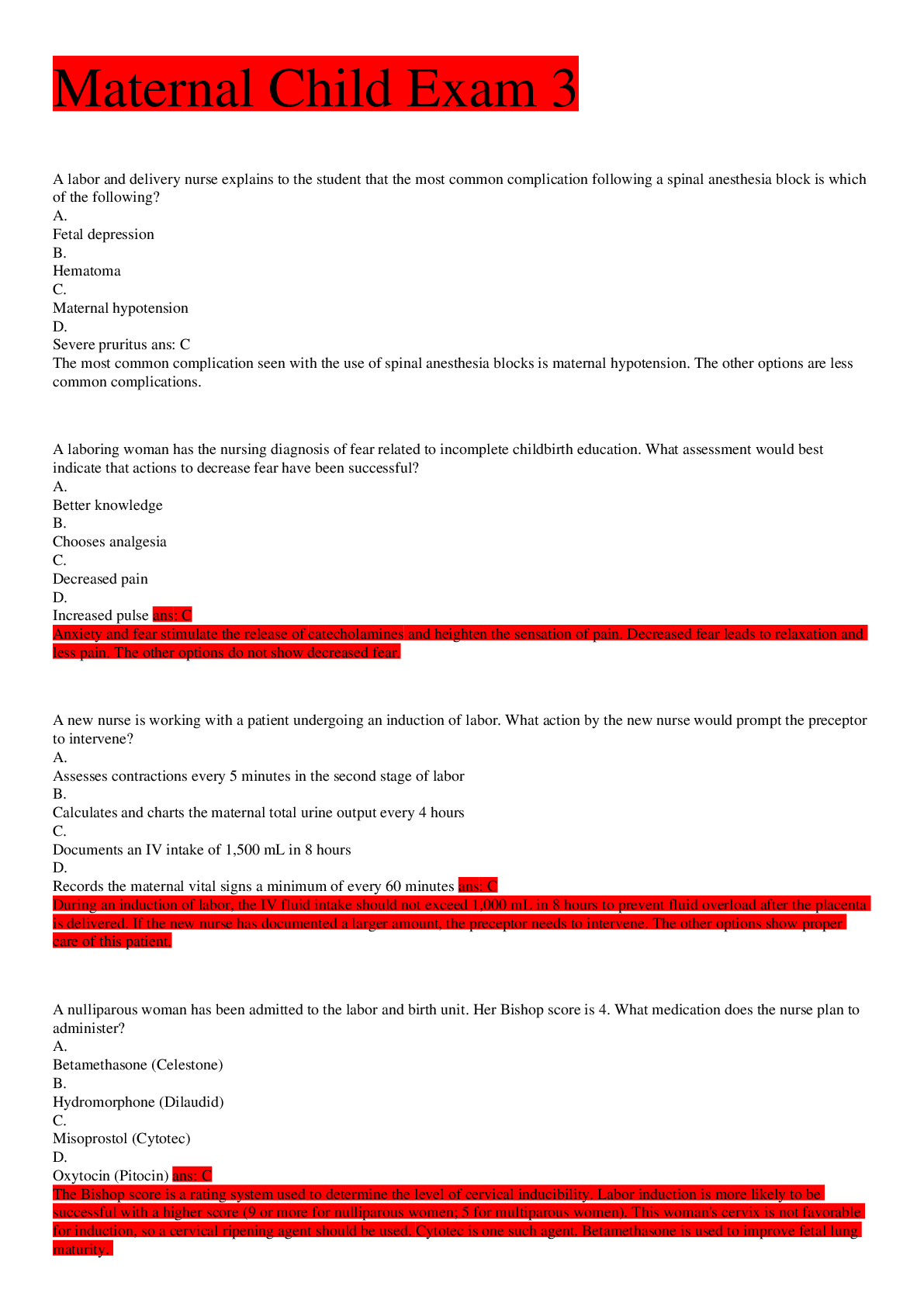

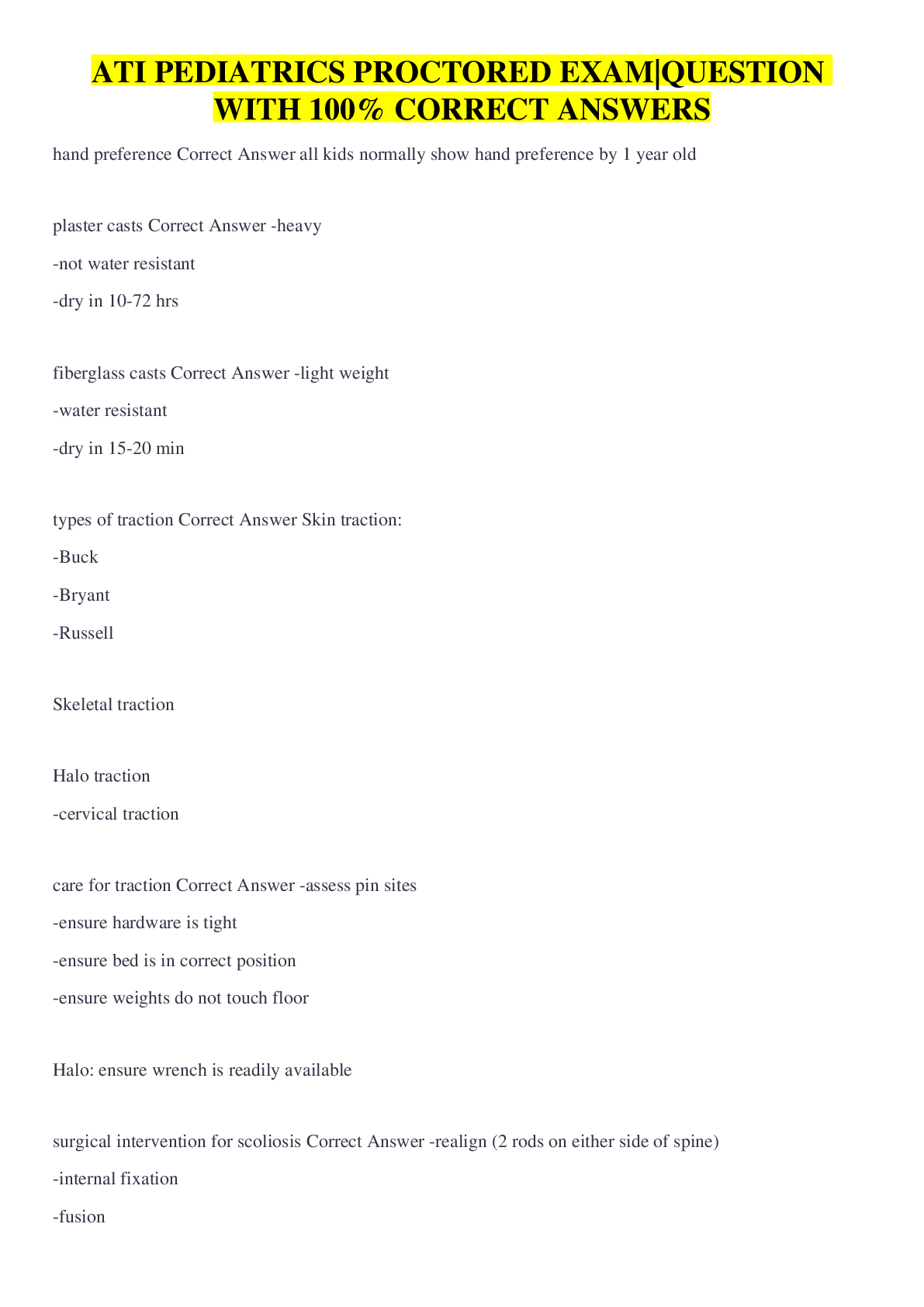
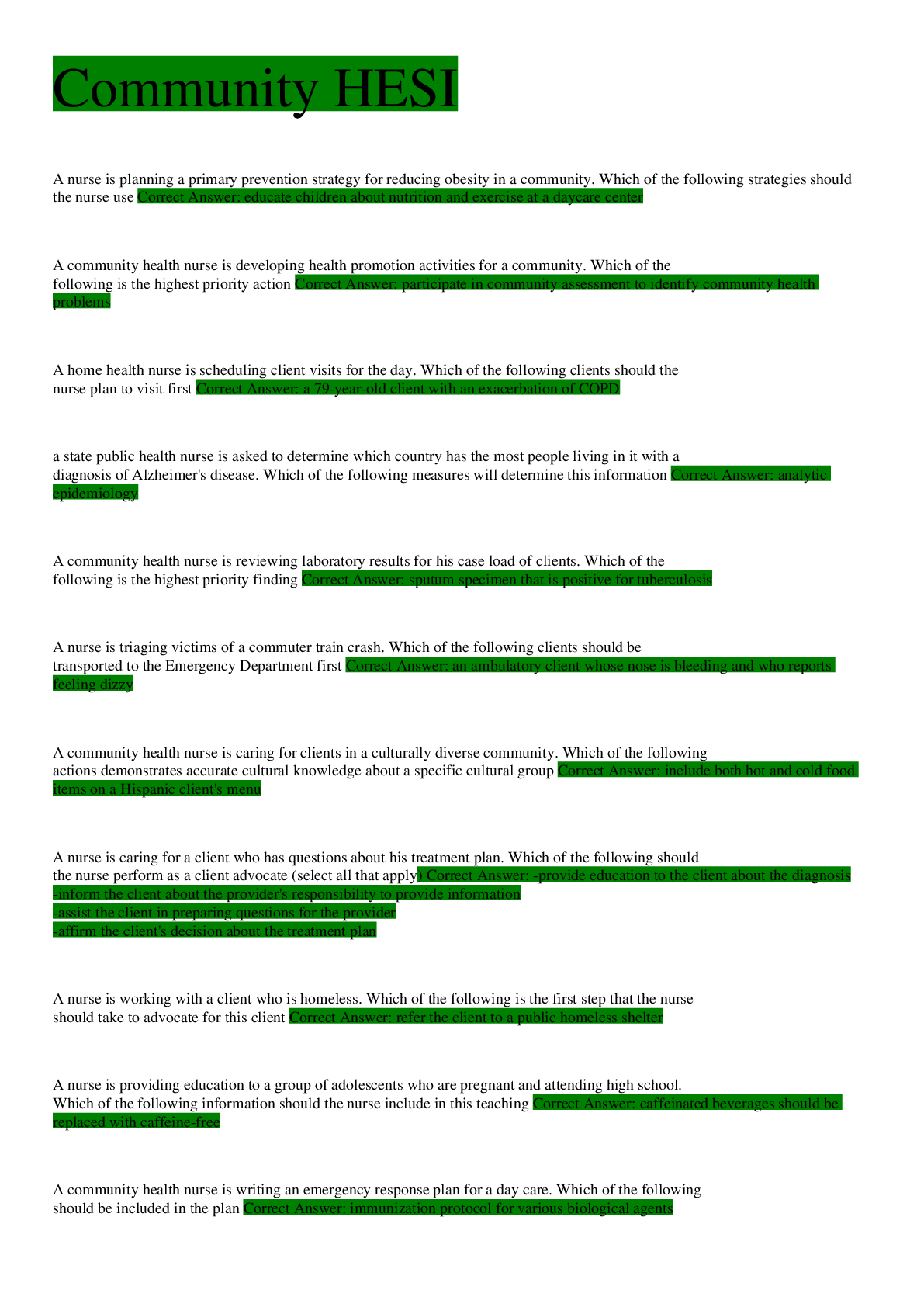
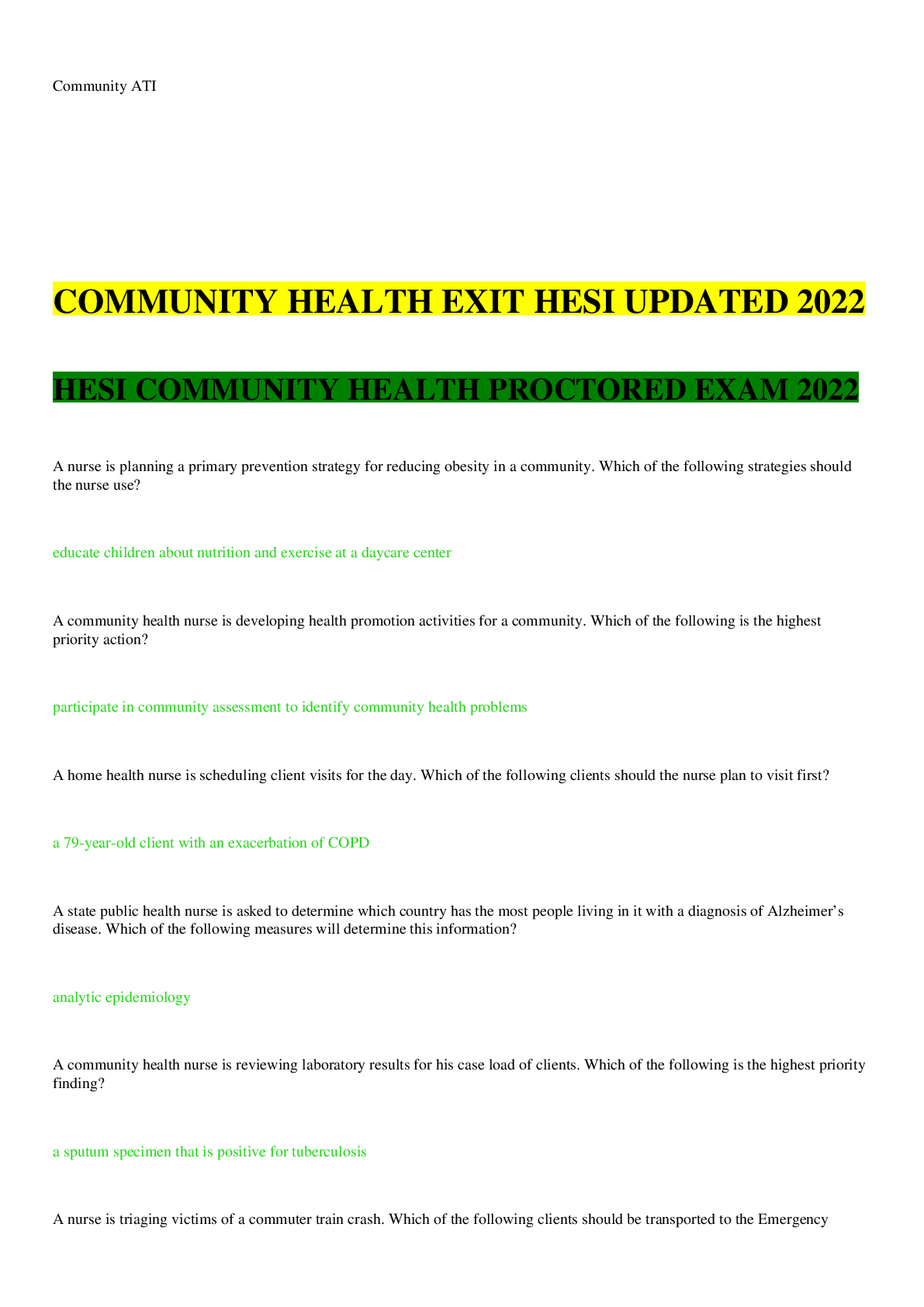
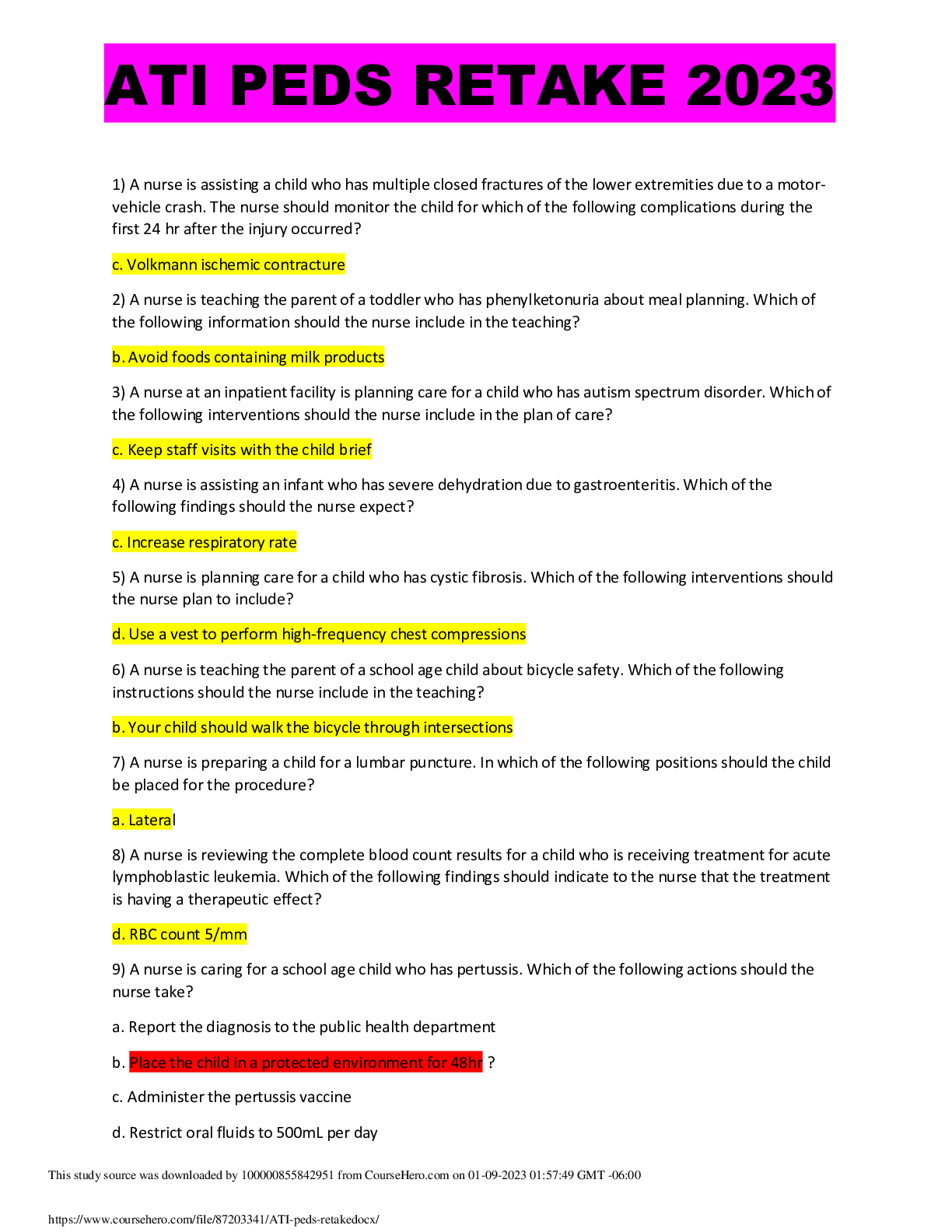


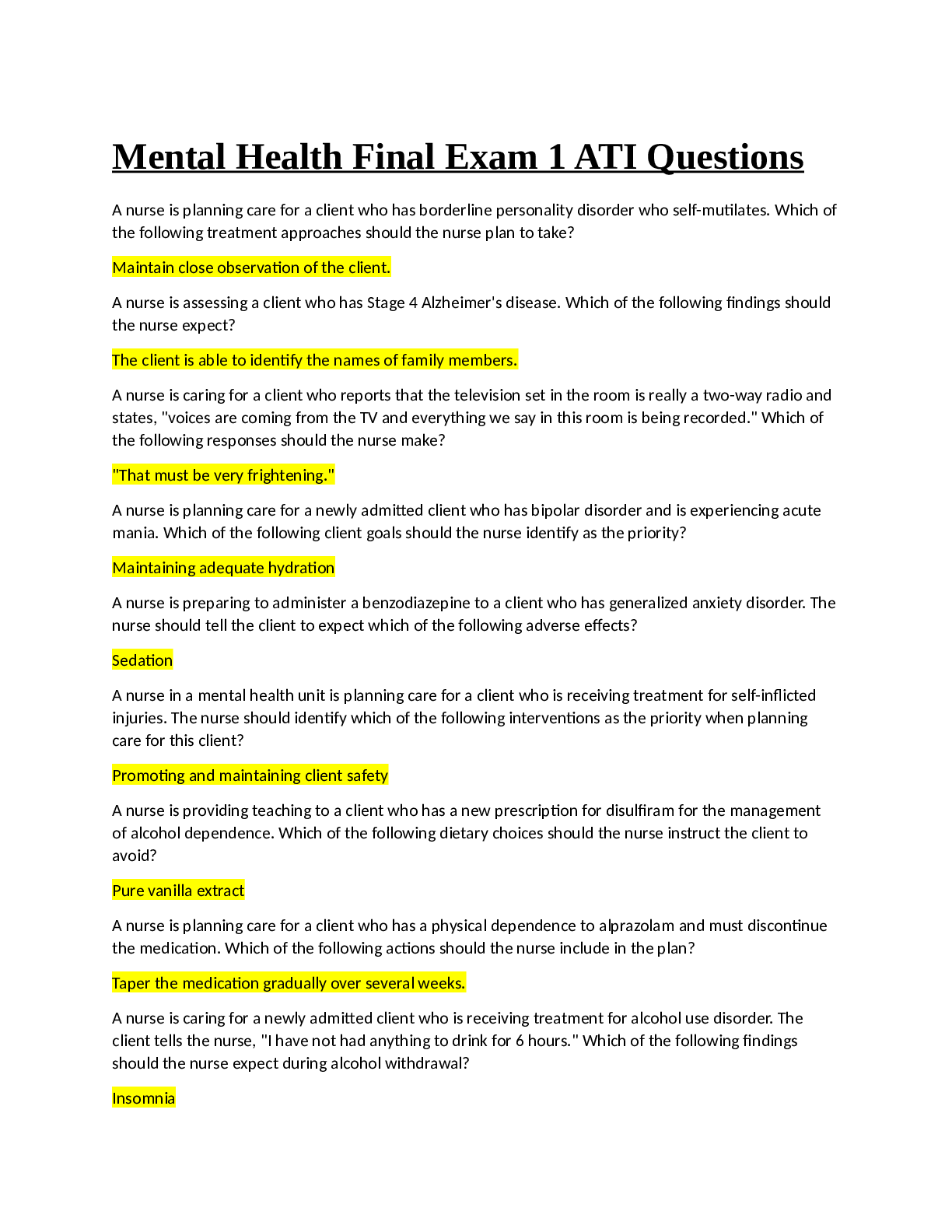



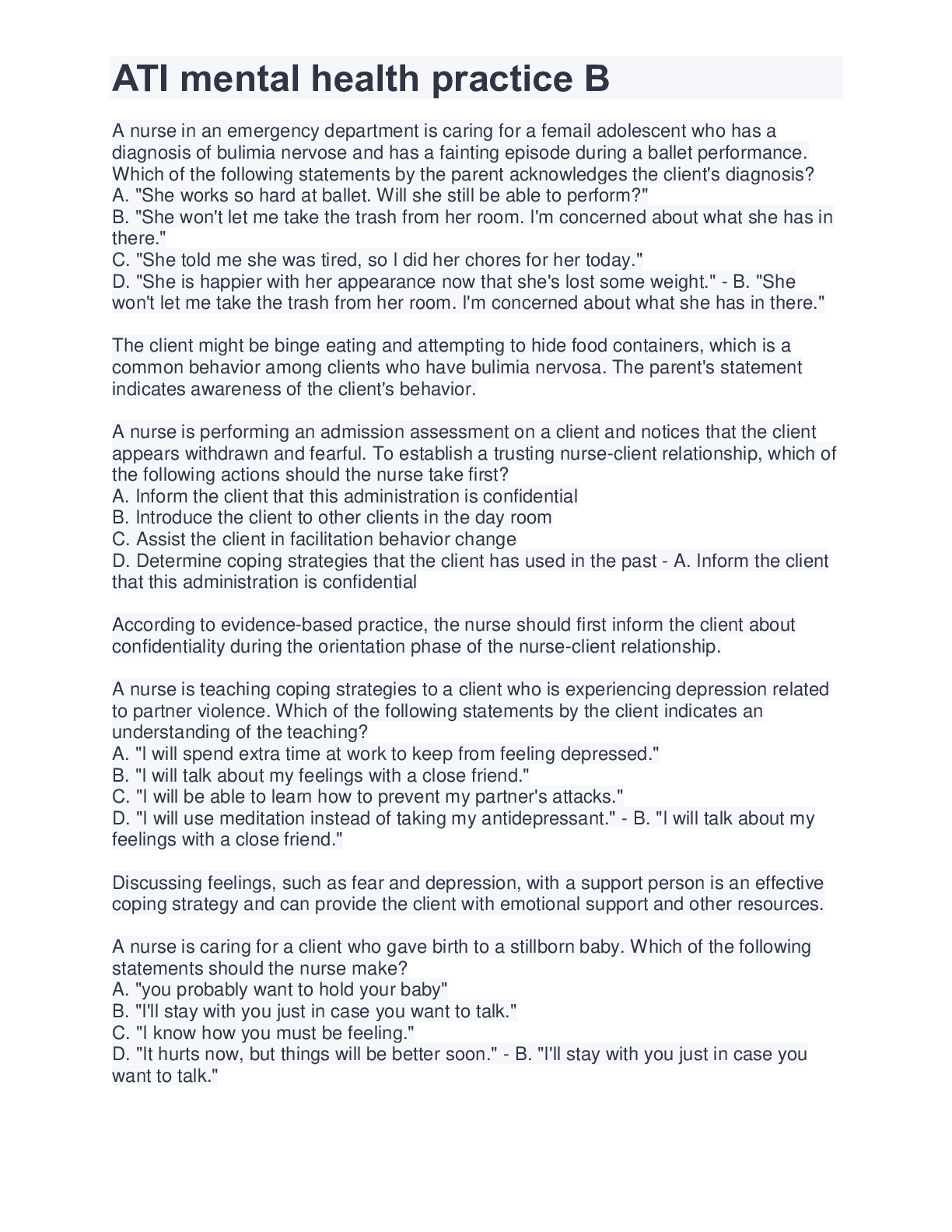


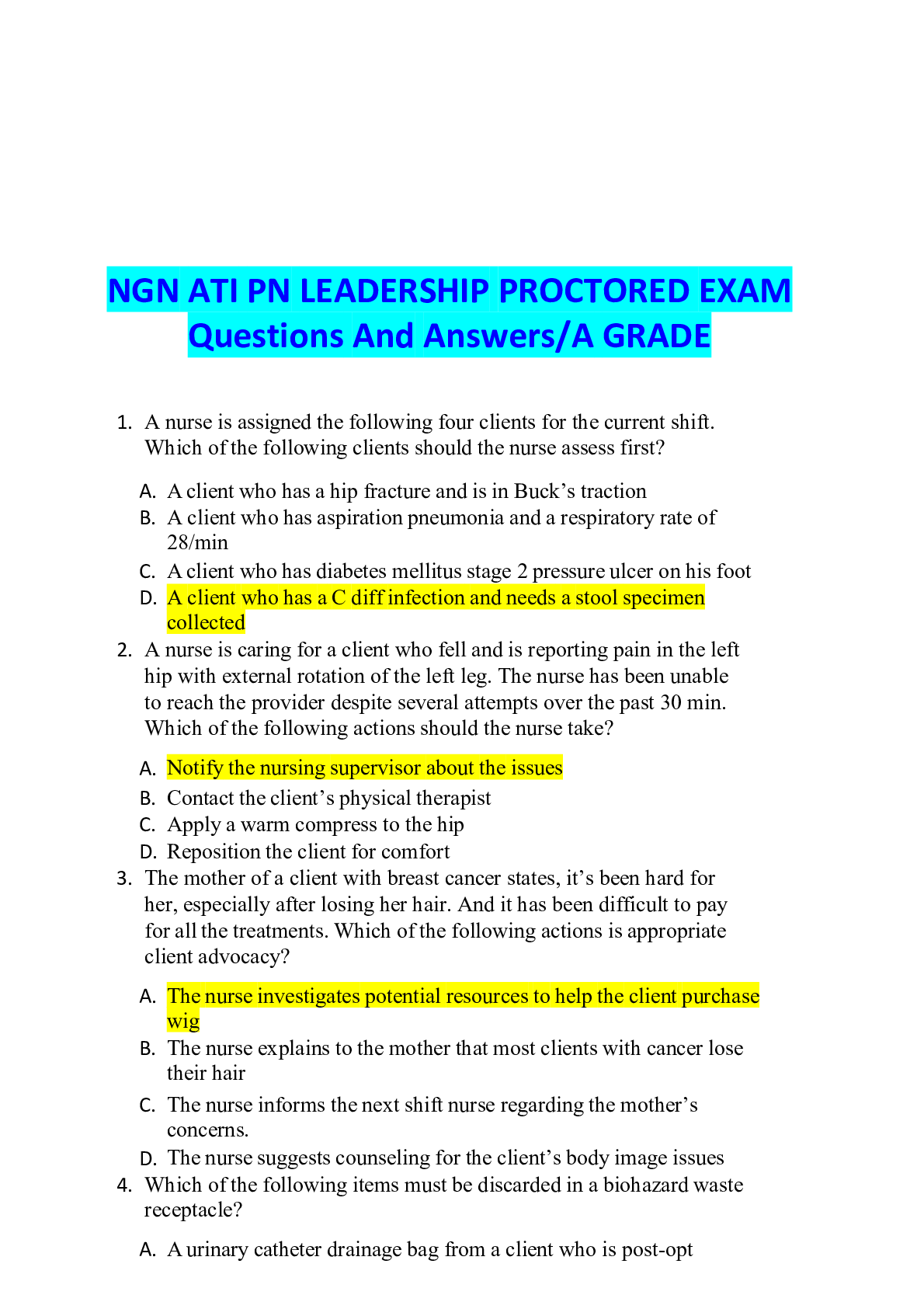
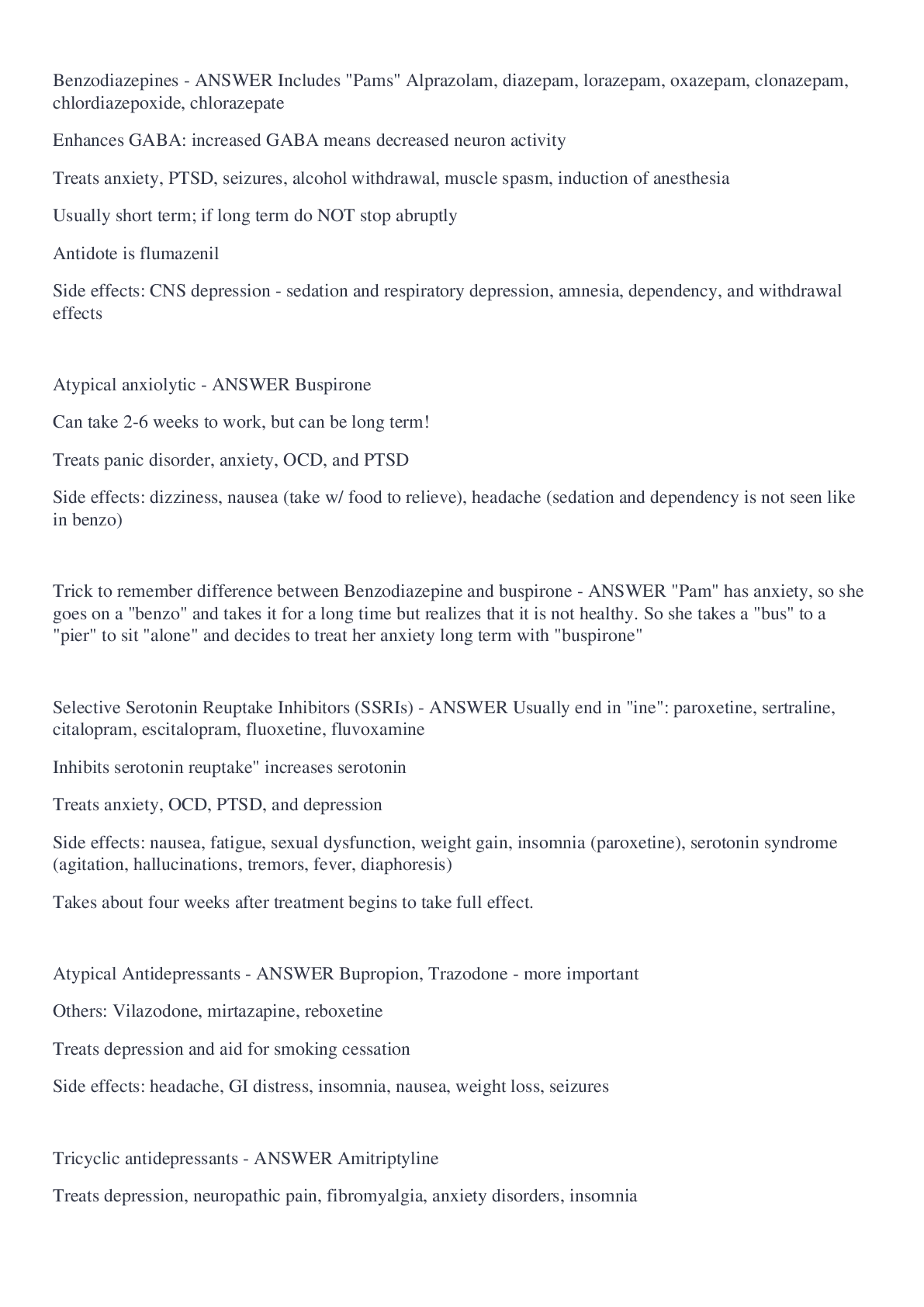

.png)
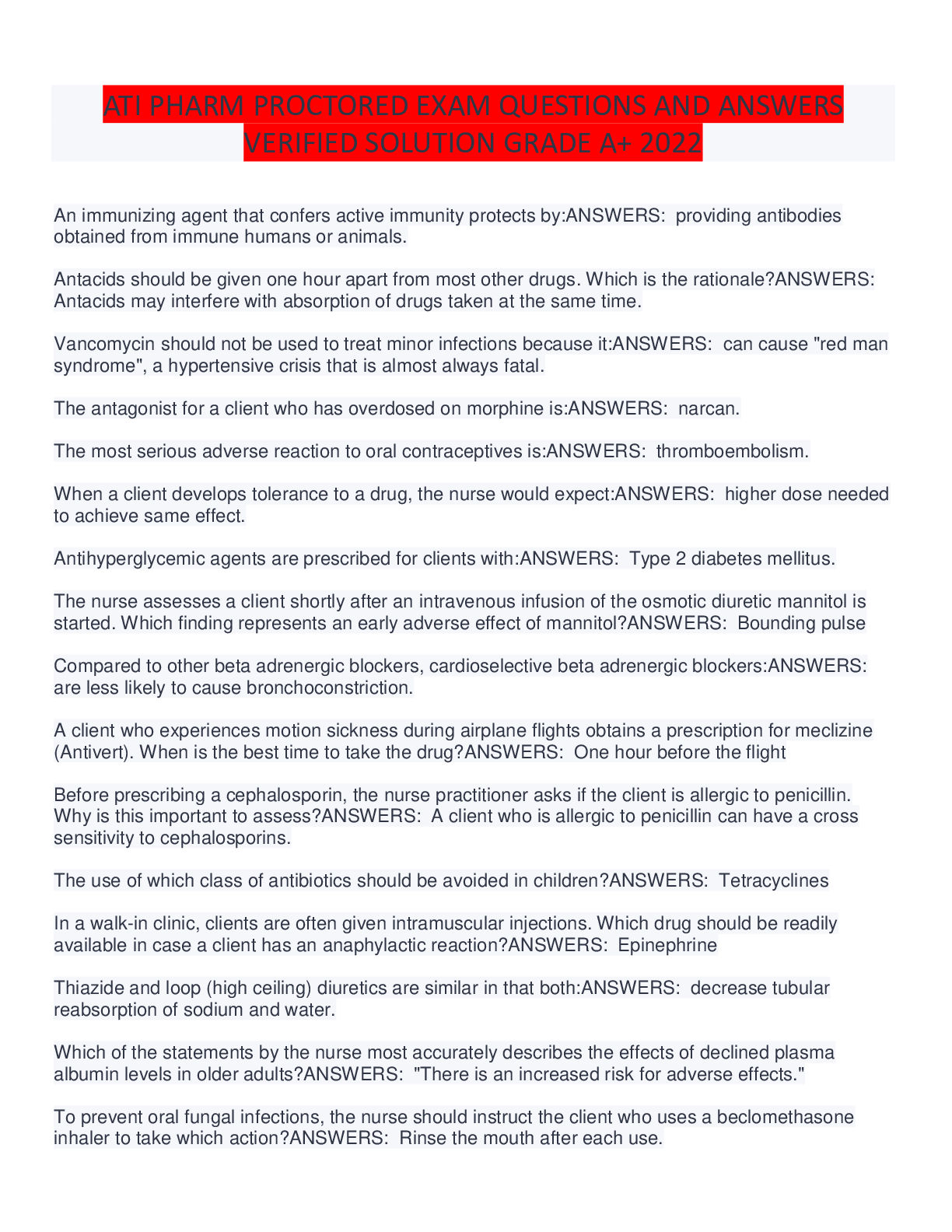
.png)
.png)
